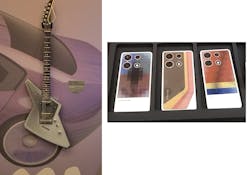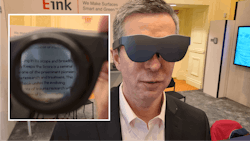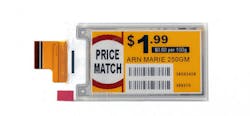ePaper Not Just for e-Readers Anymore
Check out Electronic Design's coverage of CES 2024. This video is also part of the TechXchange: Advanced Display Technology.
What you’ll learn:
- What is ePaper?
- Where is ePaper being used other than in e-readers?
Many myths abound about ePaper technology employed in e-readers, such as that it’s only slight more efficient than LCD displays. That’s far from the truth. It’s very power efficient and one of the few display technologies that can retain a static display after power is removed, making for even more efficient power use. I talked with Timothy O’Malley, Assistant Vice President of U.S. Business at E Ink, about some of the new uses of ePaper and some of the latest advances.
ePaper, or electronic paper, is a display technology that moves charged particles of different pigments in a clear fluid. This electrophoretic display (EPD) moves the particles by applying a voltage across a pixel that will retain the position of the particles after removing the voltage. Initially, ePaper provided a greyscale display, but color versions have been available for some time.
At the 2023 Consumer Electronics Show, E Ink and BMW showed off a concept car that changed color courtesy of E Ink’s color ePaper. It highlighted the ability to cover irregular shapes, not just flat displays.
This year, E Ink showcased ePaper implementations from a variety of third parties, including a guitar and smartphones that change color (Fig. 1). This would allow a user to customize and change the exterior of a device, potentially in real-time and in response to other stimuli. ePaper displays are already available on the exterior of some laptops.
I saw a sample prototype of an e-reader implemented as a set of virtual-reality glasses, although they’re only designed for reading an eBook (Fig. 2). It’s not planned for production yet, but it highlights an interesting application of ePaper. The glasses do allow for private reading as well as a hands-free way of reading a book.
E Ink sells modules (Fig. 3) and development kits in addition to working directly with companies that may require more custom implementations, such as form-fitting film. All of the implementations provide low-power operation and the ability to retain an image when power is removed.
Check out more of Electronic Design's coverage of CES 2024 and more videos/articles in the TechXchange: Advanced Display Technology.
About the Author
William G. Wong
Senior Content Director - Electronic Design and Microwaves & RF
I am Editor of Electronic Design focusing on embedded, software, and systems. As Senior Content Director, I also manage Microwaves & RF and I work with a great team of editors to provide engineers, programmers, developers and technical managers with interesting and useful articles and videos on a regular basis. Check out our free newsletters to see the latest content.
You can send press releases for new products for possible coverage on the website. I am also interested in receiving contributed articles for publishing on our website. Use our template and send to me along with a signed release form.
Check out my blog, AltEmbedded on Electronic Design, as well as his latest articles on this site that are listed below.
You can visit my social media via these links:
- AltEmbedded on Electronic Design
- Bill Wong on Facebook
- @AltEmbedded on Twitter
- Bill Wong on LinkedIn
I earned a Bachelor of Electrical Engineering at the Georgia Institute of Technology and a Masters in Computer Science from Rutgers University. I still do a bit of programming using everything from C and C++ to Rust and Ada/SPARK. I do a bit of PHP programming for Drupal websites. I have posted a few Drupal modules.
I still get a hand on software and electronic hardware. Some of this can be found on our Kit Close-Up video series. You can also see me on many of our TechXchange Talk videos. I am interested in a range of projects from robotics to artificial intelligence.



